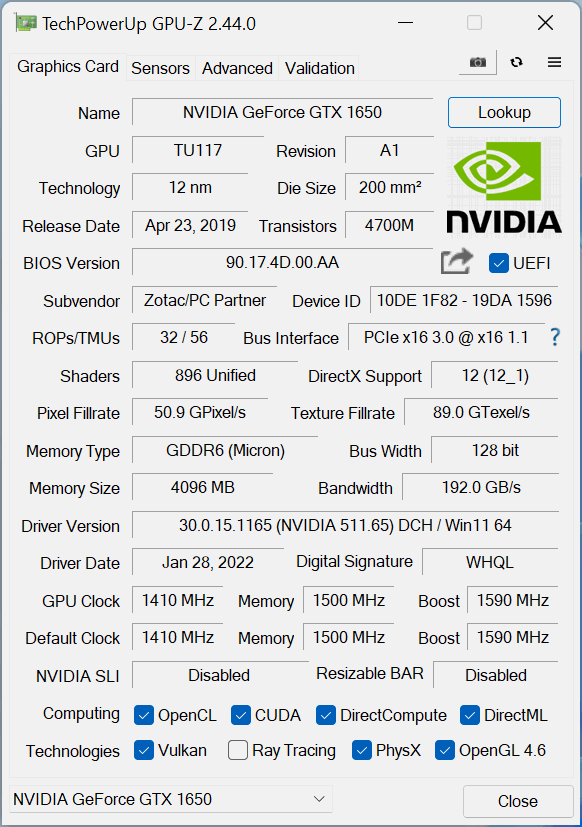Cincoze DS-1300 Industrial PC Review: Xeon-Powered Do-it-All
by Ganesh T S on March 18, 2022 8:00 AM EST- Posted in
- Systems
- Intel
- Xeon
- Embedded
- Industrial PC
- Cincoze
- Comet Lake
GPU Performance
GPUs in industrial PCs are more likely to be used for machine-learning tasks. GPU performance evaluation typically involves gaming workloads, which we will present in this section. However, given the target market, we will first look at the GPU compute performance (that also includes caffe as part of its workload set). Prior to that, a look at the capabilities of the GPU in the Cincoze DS-1302 is warranted.
The GTX 1650 inside the Cincoze DS-1302 is a Zotac card based on the TU117 Turing GPU. It is equipped with 4GB of GDDR6, and has all computing technologies other than ray tracing support.
GPU Compute Performance
All workloads in the SPECworkstation 3.1 benchmark were processed in 1080p resolution (system display running at 4Kp60). Scores are reported in the form of a SPEC ratio, with the performance of a HP Z240 tower system (using an Intel Xeon E3-1240 v5 / AMD Radeon Pro WX3100 GPU) in the denominator.
| SPECworkstation 3.1.0 - GPU Compute (SPEC Ratio - Higher is Better) |
||
| Cincoze DS-1302 | OnLogic Helix HX500 | |
| LuxRender | 1.74 | 0.46 |
| caffe | 2.14 | N/A |
| fah | 1.86 | N/A |
| Overall | 1.91 | N/A |
LuxRender uses LuxMark, a benchmark based on the new LuxCore physically based renderer, to render a chrome sphere resting on a grid of numbers in a beach scene. It supports heterogenous compute, utilizing both the CPU and GPU in the system. Caffe is a deep-learning framework benchmark, while the Folding@Home (fah) benchmark simulates protein folding and other types of molecular dynamics.
The presence of a discrete GPU enables the Cincoze DS-1302 to complete all the components successfully, with a significant performance uplift over the reference system. The HX500, with its iGPU, was not so lucky - only the LuxRender tests completed successfully.
SPECviewperf 2020.3
The SPECviewperf 2020.3 benchmark was processed with both official resolutions - 2K and 4K. These benchmarks are a measure of OpenGL performance. These tests do not run well on integrated GPUs - so, only results from the Cincoze DS-1302 are presented here.
| SPECviewperf 2020.3 (Composite Scores - Higher is Better) |
||
| 2K (1900 x 1060) | 4K (3800 x 2120) | |
| catia-06 | 24.5 | 10.28 |
| solidworks-07 | 93.73 | 22.69 |
| medical-03 | 14.21 | 4.61 |
| snx-04 | 11.17 | 7.86 |
| 3dsmax-07 | 47.2 | 24.49 |
| creo-03 | 52.28 | 35.47 |
| energy-03 | 7.22 | 4.23 |
| maya-06 | 162.34 | 70.03 |
The SPECviewperf 2020 results site does have a number of systems that can be compared against the scores in the table above.
GFXBench
The DirectX 12-based GFXBench tests from Kishonti are cross-platform, and available all the way down to smartphones, so it is not too difficult for discrete GPUs and modern integrated GPUs. We processed the offscreen versions of the 'Aztec Ruins' benchmark.
| GFXBench 'Aztec Ruins' Offscreen Benchmark (Frame Rate (fps) - Higher is Better) |
||
| Cincoze DS-1302 | OnLogic Helix HX500 | |
| Normal (1080p) | 243.65 | 39.32 |
| High (1440p) | 90.25 | 14.42 |
There is obviously a significant difference in the dGPU and iGPU performance for the 'Aztec Ruins' DX12 benchmark.
UL 3DMark
Four different workload sets were processed in 3DMark - Fire Strike, Time Spy, Night Raid, and Wild Life.
| UL 3DMark Benchmarks (Performance Scores - Higher is Better) |
||
| Cincoze DS-1302 | OnLogic Helix HX500 | |
| Fire Strike Extreme | 4283 | 672 |
| Fire Strike Ultra | 1888 | 346 |
| Time Spy Performance | 3861 | 548 |
| Time Spy Extreme | 1762 | 243 |
| Night Raid Performance | 34250 | 6923 |
| Wild Life Performance | 20866 | 3444 |
| Wild Life Extreme | 6925 | 997 |
As expected, the discrete GPU-equipped Cincoze DS-1302 outscores the HX500 with its integrated GPU in the 3DMark workloads.











5 Comments
View All Comments
usiname - Saturday, March 19, 2022 - link
$1200 to upgrade from 64gb m.2 to 2tb, why not?Excelsior00 - Sunday, March 20, 2022 - link
Apple: *chuckles*back2future - Monday, March 21, 2022 - link
What's the reason for this in-line PCIe connectors (prob. PCIe x16 and x1?)?https://www.anandtech.com/Gallery/Album/8127#4
back2future - Friday, March 25, 2022 - link
learned it's for custom made riser cards, extending this in-line connectors to either "x16/x1 PCIe" or "x16 PCIe/PCI" or "2x x8 PCIe" or "2x PCI" slots combinations (for 1302, reduced for 1301 to single slots 16xPCIe or PCI)Lord of the Bored - Thursday, March 24, 2022 - link
Oh my gosh, I want those CMI modules to become an industry standard! They're basically a way to build your own ATX IO block!